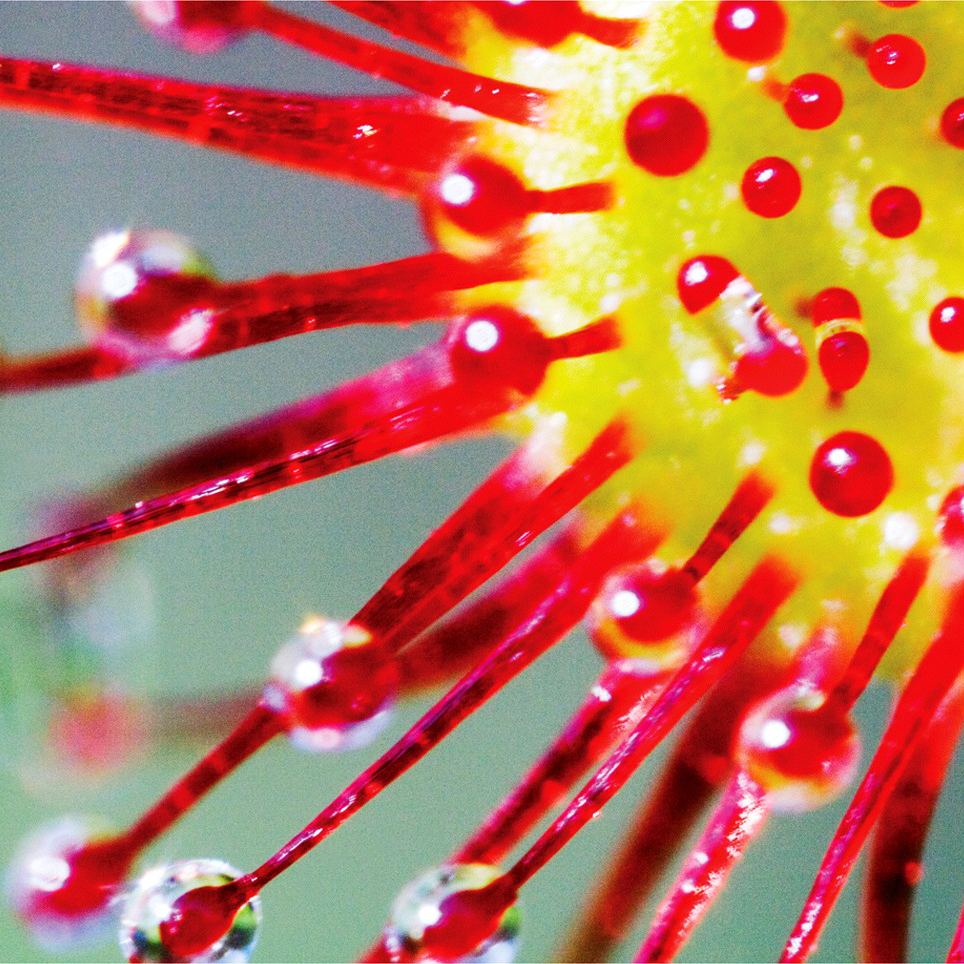
Chapter 1. Chapter 32: Plant Physiology
1.1 Introduction

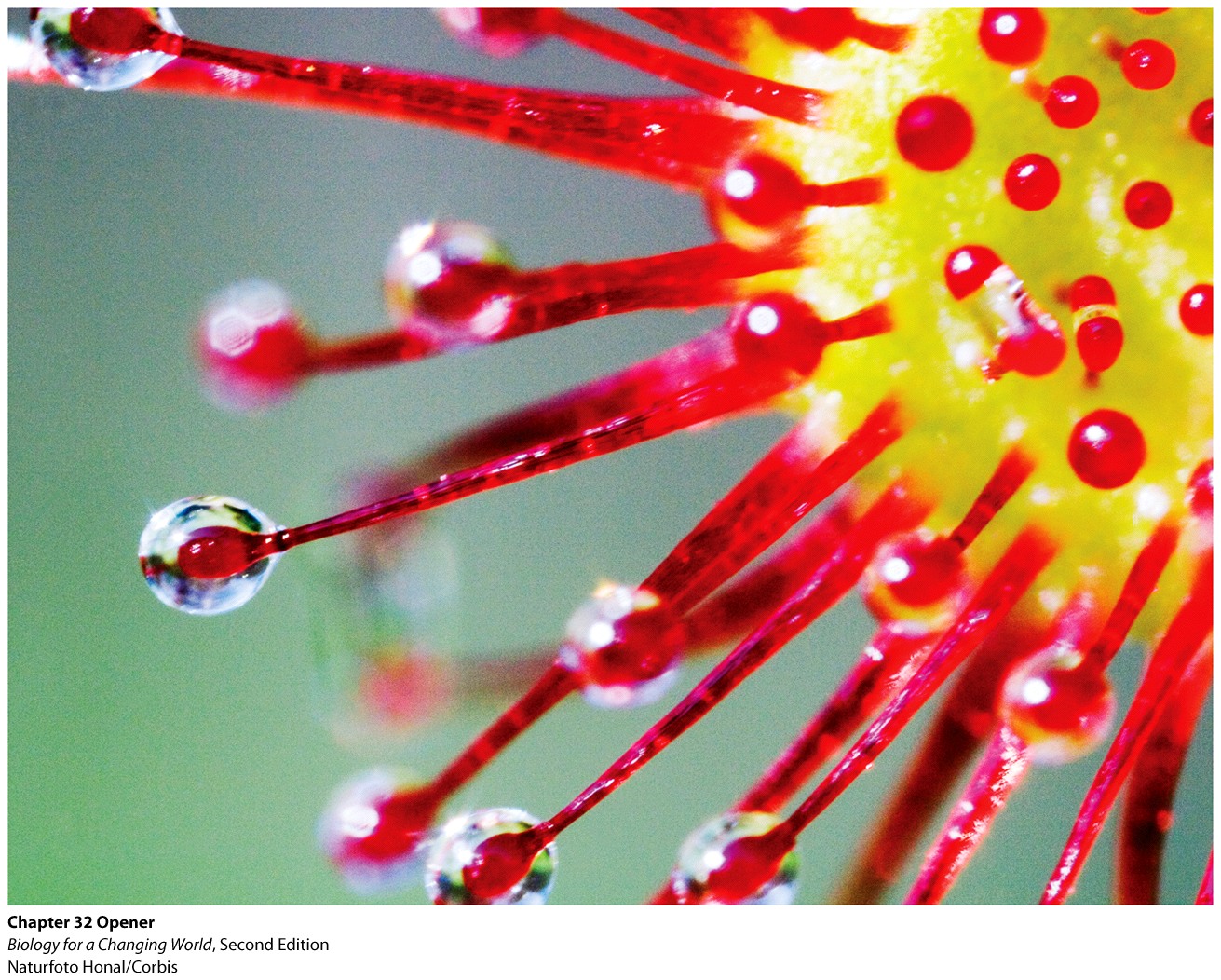
Welcome to the Interactive Study Guide for Chapter 32: Plant Physiology! This Study Guide will help you master your understanding of the chapter's Driving Questions, using interactive Infographics and activities, as well as targeted assessment questions. Click "Next" to get started, or select a Driving Question from the drop-down menu to the right.
Q&A Plants:
Exploding seeds, carnivorous flowers, and other colorful adaptations of the plant world
DRIVING QUESTIONS
- How is a plant body structured, and how do plants obtain water and grow?
- How do plants obtain nutrients?
- How do plants reproduce, respond to stimuli, and protect themselves?
1.2 Driving Question 1:
Driving Question 1
How is a plant body structured, and how do plants obtain water and grow?
Why should you care?
For many, it's hard to care about plants because they are so different from us and because they appear so stationary. It may be surprising to think of plants as having a physiology, since they seem so inert. You have already learned that plants are the basis of the terrestrial food webs, including the food web that feeds humans. Understanding how these important organisms work will help you appreciate their significance to your daily life.
What should you know?
To fully answer this Driving Question, you should be able to:
- List and describe the function of most common parts of the root system and shoot system in plants.
- List and describe the function of most common parts of plant cells.
- Compare and contrast xylem and phloem.
- Explain how transpiration works.
Infographic Focus
The Infographics most pertinent to the Driving Question are 32.1 and 32.2.
Test Your Vocabulary
Choose the correct term for each of the following definitions:
| Term | Definition |
|---|---|
| A rigid layer surrounding the cell membrane of some cells, providing shape and structure. In plant cells, the cell wall is made of cellulose, a complex carbohydrate. | |
| A long, straight root produced by some plants that stores water and carbohydrates. | |
| Pores on leaves that permit the exchange of oxygen and carbon dioxide with the air and allow water loss. | |
| The belowground parts of a plant, which anchor it and absorb water and nutrients. | |
| The pressure exerted by the water-filled central vacuole against the plant cell wall, giving a stem its rigidity. | |
| Tube-shaped vessels and tissues that transport nutrients throughout an organism’s body. | |
| The organelle in plant cells in which photosynthesis takes place. | |
| The loss of water from plants by evaporation; powers the transport of water and nutrients through a plant’s vascular system. | |
| The aboveground parts of a plant, including the stem and photosynthetic leaves. | |
| A stiff strengthening agent found in secondary cell walls of plants. | |
| Plant vascular tissue that transports water from the roots to the shoots. | |
| The waxy coating on leaves and stems that prevents water loss. | |
| Tiny extensions of root cells that increase the surface area of roots and enhance their ability to absorb water and nutrients. | |
| A fluid-filled compartment in plant cells that contributes to cell rigidity by exerting turgor pressure against the cell wall. | |
| Plant vascular tissue that transports sugars throughout the plant. |
List and describe the function of most common parts of the root system and shoot system in plants.
1.
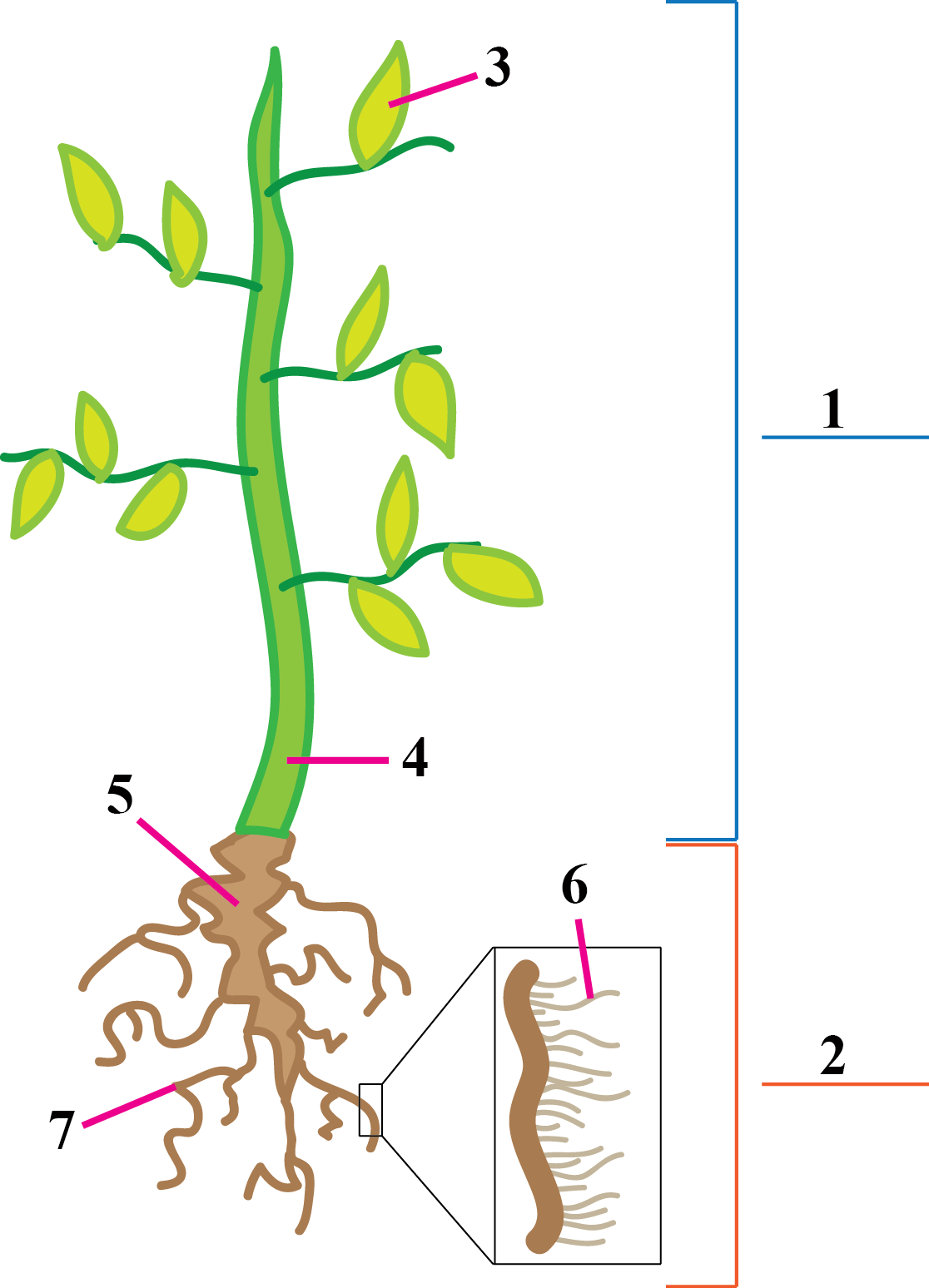
Name each item on the diagram and briefly describe the general function of each part.

- Shoots: leaves and stem of plant
- Roots: anchor plant in ground; absorb water and minerals from soil
- Leaf: where photosynthesis happens, carbon dioxide enters, and water leaves the plant
- Stem: upright support for the plant
- Taproot: long, straight root that goes deep into the ground to reach underground water; also is a strong anchor for plant
- Root hairs: extensions of root cells; enhance absorption of water and nutrients from the soil
2.
Think back to Chapter 26. Is there a component of the human digestive system that has a function similar to that of root hairs on plants? Explain.
In the digestive system, the epithelial cells lining the digestive tract have fingerlike projections called cilia. These increase the surface area of the digestive tract so that more nutrients can be absorbed, much like the root hairs on plant roots.
List and describe the function of most common parts of plant cells.
3.
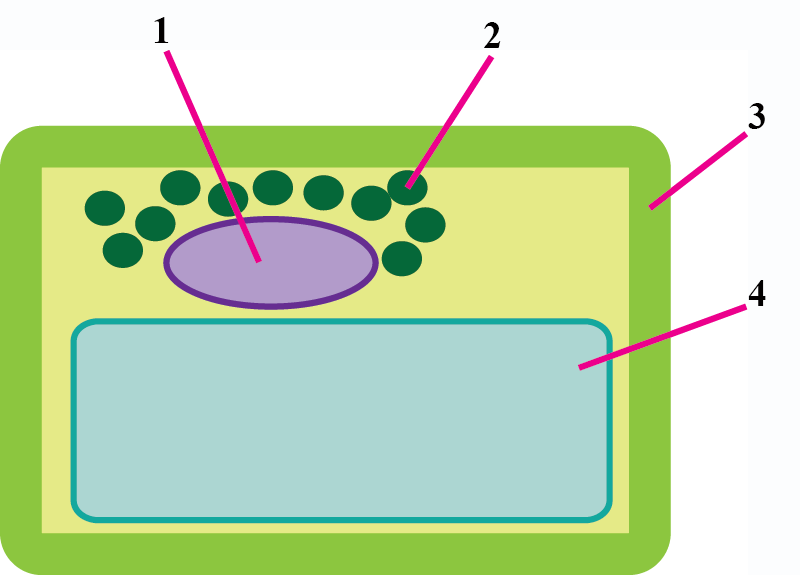
Name the part of the plant cell indicated by each line and number and describe its main function(s). (If you are having a hard time labeling the parts of the cell, refer to Infographic 3.8)
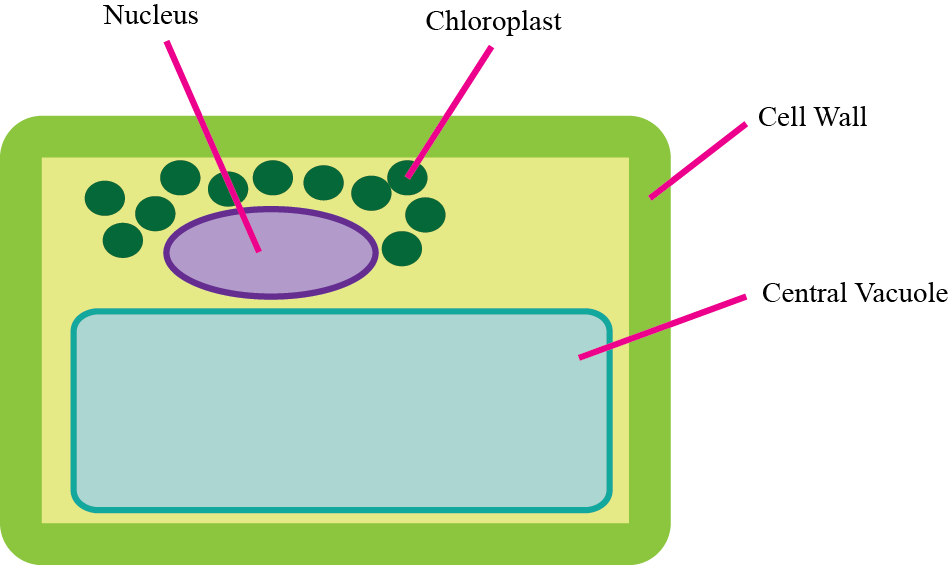
- Nucleus: location of plant chromosomes; control center of the cell
- Chloroplast: location of photosynthesis, typically found in green tissues
- Cell wall: rigid wall made of cellulose; gives structure and support to cell
- Central vacuole: large compartment filled with water that puts turgor pressure against the cell wall and gives the plant cell a firm shape
Compare and contrast xylem and phloem.
4.
Fill in the following table comparing xylem and phloem:
| Xylem | Phloem | |
|---|---|---|
| Transports |
*Fill in: |
*Fill in: |
| Direction of Transportation |
*Fill in: |
*Fill in: |
| Thought question: What role does it play in photosynthesis? |
*Fill in: |
*Fill in: |
| Xylem | Phloem | |
|---|---|---|
| Transports | Water | Sugar |
| Direction of Transportation | Toward the leaves | Toward the leaves and roots |
| Thought question: What role does it play in photosynthesis? | Water is an integral part of photosynthesis, as electrons released from the splitting of water molecules replace electrons lost by light-excited chlorophyll molecules. A beneficial byproduct of water splitting is the oxygen we breathe. | One of the final products of photosynthesis is glucose. This energy-containing molecule must be transported to every part of the plant and so travels by way of the phloem. |
Explain how transpiration works.
5.
What force draws water from a plant’s roots to its leaves?
6.
How does water leave the leaves?
7.
How does carbon dioxide enter the leaves?
8.
Which part of the vascular system allows transpiration to occur?
Review Questions
9.
A plant cell wall is made of:
| A. |
| B. |
| C. |
| D. |
| E. |
10.
The shoot system contains ____________.
| A. |
| B. |
| C. |
| D. |
| E. |
11.
The central vacuole provides structural support for a plant cell by:
| A. |
| B. |
| C. |
| D. |
| E. |
12.
Xylem moves ____________ a plant.
| A. |
| B. |
| C. |
| D. |
| E. |
13.
The pathway water takes during transpiration includes the following EXCEPT:
| A. |
| B. |
| C. |
| D. |
| E. |
1.3 Driving Question 2:
Driving Question 2
How do plants obtain nutrients?
Why should you care?
As you've read many times by now, it is important that plants undergo photosynthesis so that life can exist on Earth. All of the energy you get from food was originally captured by plants—even if you rarely eat them. Except for mineral supplements and mineral-fortified foods, all of the elements in your body were once part of a plant. Many of the vitamins and other essential molecules we need are made by plants as well. Plants have many strategies to capture these nutrients and energy, and understanding and appreciating how they do this may prevent you from skipping that salad at dinner.
What should you know?
To fully answer this Driving Question, you should be able to:
- Explain the strategies plants use to obtain nutrients from their environment.
- Explain the dilemma faced by plants in hot, arid climates.
- Explain strategies used by plants to conserve water.
Infographic Focus
The Infographics most pertinent to the Driving Question are 32.3 to 32.5.
Explain the strategies plants use to obtain nutrients from their environment.
14.
List four items that are necessary for plants to grow and describe where they are found in the environment:
- Water; soil
- Carbon; air
- Nitrogen; soil; first must be processed by nitrogen-fixing bacteria such as Rhizobium
- Sunlight; atmosphere
15.
How do plants obtain carbon from the environment?
Carbon dioxide enters the plant leaves through the stomata.
16.
Describe two strategies plants use to obtain nitrogen:
Plants can obtain nitrogen by partnering with nitrogen-fixing bacteria or by trapping and dissolving insects.
Explain the dilemma faced by plants in hot, arid climates.
17.
Why is it good for a plant to have its stomata open during the day?
18.
What is the drawback to plants of having stomata open during the day in a dry climate?
19.
What are the benefits and drawbacks of keeping stomata closed during the day in a hot climate?
The benefit of keeping stomata closed during the day is water conservation. The drawback is that no carbon dioxide would enter the leaf and photosynthesis would not occur (i.e., no sugar produced).
Explain strategies plants use to conserve water.
20.
In the previous questions, you described the trade-off faced by plants in hot, arid climates. However, you probably also know that some kinds of plants, such as cacti, thrive in this environment. Describe three strategies plants use to conserve water.
- Physical measures: waxy, thick leaves (again, think of a cactus).
- Ability to use low levels of carbon dioxide: some plants keep their stomata closed for most of the day but are still able to use minute levels of carbon dioxide trapped in the plant’s internal air pockets to feed photosynthesis.
- Splitting the process of photosynthesis: some plants that thrive in the desert keep their stomata closed during the day and collect carbon dioxide at night. The nocturnally collected carbon dioxide is stored in the leaves of the plant until the next morning, when sunlight drives photosynthesis.
Review Questions
21.
Open stomata during the day allow for the following EXCEPT:
| A. |
| B. |
| C. |
| D. |
| E. |
22.
The carbon that is found in plant stems, roots, and leaves comes from the:
| A. |
| B. |
| C. |
| D. |
23.
What do plants obtain through digestion of insects?
| A. |
| B. |
| C. |
| D. |
1.4 Driving Question 3:
Driving Question 3
How do plants reproduce, respond to stimuli, and protect themselves?
Why should you care?
Most people think of flowers in terms of what they symbolize: love, mourning, beauty. In an arrangement or on a parade float, they become simple splashes of color. For plants, flowers mean sex. A flower is an efficient device to facilitate sex in plants, usually by attracting animals to help transfer gametes for them. Flowers and sexual reproduction in plants have given rise to the amazing diversity of plants on the planet, which makes all our lives richer.
Like flowers, seeds have long been symbols, usually of beginnings; this is perhaps a more apt comparison. Seeds are analogous in many respects to eggs: they have a protective covering that contains a developing embryo and an energy source for its development. Unlike the eggs of most animals, seeds are meant to be dispersed away from the parents, and there are several methods plants use for seed dispersal.
Although plants do not have nerves or think in any way analogous to the way we do, they do sense their environment and respond to it, sometimes with surprising speed. By learning about how plants react to their environment you will begin to see plants more as active organisms and less as inert objects.
Plants use a variety of physical and chemical defenses to prevent being eaten or otherwise bothered. Some plants even employ animals for protection. For example, some tropical trees provide shelter and nectar in swollen parts of their stems to ants in exchange for them biting or stinging any other animal, thus warding off would-be predators. Plant defense strategies may have shaped the development of agriculture. Some scholars point out that humans have tended to domesticate vegetable crops that are either poisonous or otherwise inedible without processing. For example, broccoli, cabbage, and other similar mustard-family vegetables produce chemicals that are poisonous or distasteful to most insects but not to us. Artichokes are actually giant thistles, covered with prickles that make them inedible without use of a knife. Cassava, the main starch vegetable for most of the tropical world, naturally has toxic levels of cyanide until processed properly. We have also benefited from some plants’ chemical defenses, which are useful as medicines.
What should you know?
To fully answer this Driving Question, you should be able to:
- Identify the parts of a flower used in sexual reproduction.
- Explain the events that take place during pollination.
- Explain the basic features and functions of seeds and which members of the plant kingdom produce them.
- Describe some of the seed dispersal methods plants use.
- Explain how the hormone auxin is used in a plant's response to light, gravity, and physical contact.
- Explain how plants evade predation.
Infographic Focus
The Infographics most pertinent to the Driving Question are 32.6 to 32.11.
Test Your Vocabulary
Choose the correct term for each of the following definitions:
| Term | Definition |
|---|---|
| Cone-bearing seed plants. | |
| Small, thick-walled structures containing cells that will develop into sperm. | |
| Conversion of atmospheric nitrogen into a form that plants can use to grow. | |
| The male reproductive organ of a flower. | |
| The process in which a seed comes out of dormancy and a new plant begins to grow. | |
| The female reproductive organ of a flower. | |
| The transfer of pollen from a stamen to a pistil. | |
| The growth of a plant toward light. | |
| Flowering plants. | |
| The response of plants to touch and wind. | |
| A plant hormone that causes elongation of cells. | |
| An embryonic plant contained in a protective structure. | |
| The growth of plants in response to gravity. Roots grow downward, with gravity; shoots grow upward, against gravity. |
Identify the parts of a flower used in sexual reproduction.
24.
In your notebook, draw and label a flower using the following terms: stamen, anther, filament, stigma, style, pistil, ovary, ovule, eggs, pollen. You can reproduce the diagram in Infographic 32.6 or draw a real flower and identify its parts. (Hint: avoid daisies, mums, and other flowers like them. They are more complex than the typical flower.)

Explain the events that take place during pollination.
25.
Describe the events that occur during pollination using the following terms: stamen, anther, pollen, pollinator, stigma, style, ovary, ovule, and egg.
Explain the basic features and functions of seeds and which members of the plant kingdom produce them.
26.
List the two groups of plants that produce seeds and the seed-producing structure associated with each.
Angiosperms; fruit
27.
Why do you think that seed-bearing plants dominate the plant world?
Describe some seed dispersal methods.
28.
Match the plant seed with its likely dispersal method.
| Very small, light seeds | |
| Bursting seed pod | |
| Fleshy, sweet encasing | |
| Sticky, flat seed | |
| Seed with a large, hollow center |
Explain how the hormone auxin is used in a plant's response to light, gravity, and physical contact.
29.
What is one major functions of the plant hormone auxin?
30.
Does auxin always make stems and roots bend? Why?
31.
Consider these two potted seedlings.
One is kept upright and the other is tipped over and kept sideways. Both are illuminated from above.
If the first diagram represents how the plants look on day 1 of the experiment (the day that you tip the one pot over), how would you expect the seedlings to look on day 7?
In your notebook, draw your prediction in the empty pots and indicate:
- where most of the auxin is found in the plant on day 1 for both conditions. Use an arrow to indicate where the auxin is.
- where most of the auxin is found in the plant on day 7 for both conditions. Use an arrow to indicate where the auxin is.
- the response that is occurring for both conditions.. (Hint: May be more than one.)

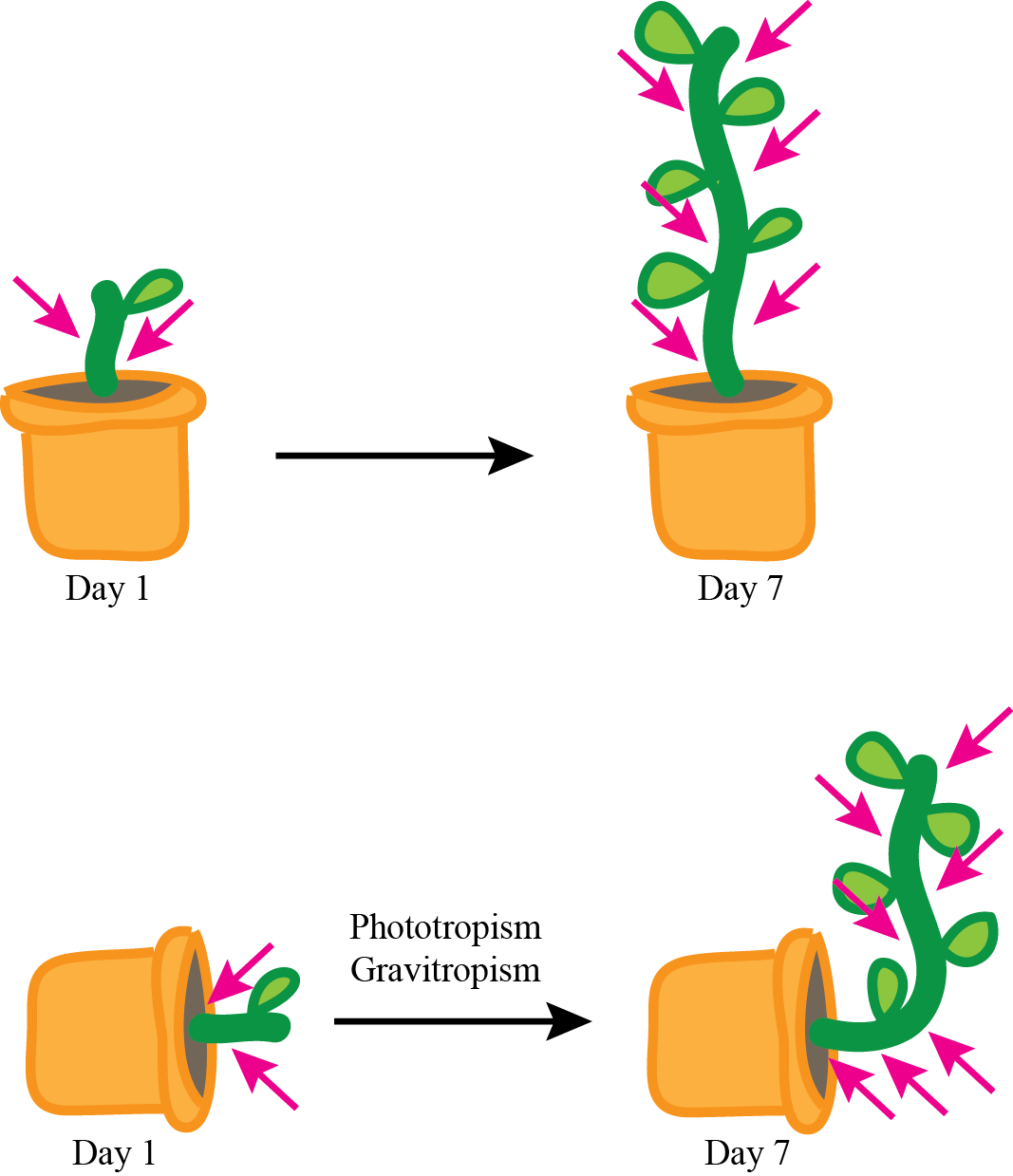
Explain how plants use defenses to evade predation.
32.
Virtual Scavenger Hunt
Using keywords such as chemical defense, mechanical defense, and avoidance of predation, find three more examples of defenses used by plants and describe them.
- Growing in a location not easily accessible to herbivores. Avoids predation by staying out of reach.
- Thigmotropism, a mechanical defense. In response to touch, the plant can close its leaves around itself to protect itself from herbivory.
- By mimicking insect predators, plants can prevent herbivory by scaring away potential threats.
- Some plants shed their leaves if they detect insect pests, a mechanical defense.
Review Questions
33.
Which of these is not part of the female reproductive system in plants?
| A. |
| B. |
| C. |
| D. |
| E. |
34.
The angio- in angiosperm refers to:
| A. |
| B. |
| C. |
| D. |
| E. |
35.
True or False: The pollen from one plant cannot fertilize the eggs from that same plant.
| A. |
| B. |
36.
Which is NOT a known method of plant seed dispersal?
| A. |
| B. |
| C. |
| D. |
37.
For root cells, more auxin causes ____________. For stem cells, more auxin causes ____________.
| A. |
| B. |
| C. |
| D. |
Activity results are being submitted...